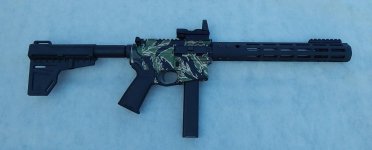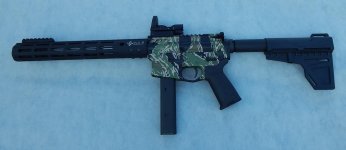hol
I have two "AR-9s". One is a 10.5" Rock River Arms pistol, with a brace added to it after the ATF amended it's ruling and determined that the mere use of a firearm did not define it's category. The 10.5" designation is a bit inaccurate as it's based on the overall length of the 10.5" barrel pistol in 5.56mm.
However, since the AR-9 is blow back operated, there's no need for locking lugs on the bolt or a barrel extension on the end of the barrel. Consequently, the bolt face on an AR-9 is at the front of what would be the start of the bolt carrier on a 5.56mm AR, so a "10.5" AR-9 barrel really measures about 11.25" from muzzle to bolt fac.
My other AR-9 is a 16" 9mm carbine that started life as a PSA factory gun, but ended up with a Ballistics Advantage barrel and an RRA upper receiver. ( I was not impressed with the accuracy or stability of the PSA barrel.)
----
The change in the ATF position on braces was important. If the old interpretation that holding a brace on an AR-15 pistol against your shoulder made it rifle had bene upheld and extended, it would have also meant that shooting your 1911, or pretty much any other pistol or revolver with a two hand grip would have made them a "rifle", since pistols and revolvers are designed so that they can be fired with one hand.
The ATF screw up was in initially allowing braces to be installed at all, and once that horse was out of the barn they couldn't really stop it.
----
With that in mind, absent additional legislation banning them, braced pistols are here to stay and they offer a number of advantage over a short barrel rifle (SBR). There is no tax stamp requirement. $200 for the stamp isn't that big a deal, but the fact that you may be waiting the better part of a year is a major inconvenience. Also, many states do not allow SBRs, so you are limited in the places you can own them and take them. You also have to have ATF permission to take them to another state, and while you can fill out a form for each state and have start and end dates that are up to one year apart, it's still a process you have to complete in advance, and at least once a year, and then wait for approval. Finally, may states have concealed carry permits that are restricted to handguns only so while you can carry a loaded brace equipped pistol in your truck under a concealed carry permit, you can't do that in some states with an SBR.
----
I'm in agreement with the OP that I prefer my AR pistols to be in 9mm Para.
The 5.56x45 round is obnoxiously loud in even a 10" barrel, and depending on the load, you're looking at 2300-2500 fps in a 10.5" barrel, which is well below the 2700 fps threshold where 5.56mm bullets stop tumbling on impact.
In contrast, you can launch 115 gr 9mm bullet at around 1500 fps in a 10.5 barrel and at nearly 1600 fps in a 16" barrel. That's not stellar performance by rifle standards, but it's impressive for a pistol round and gives a 9mm "pistol" an effective range of around 200 yards. I get a least 2 MOA 100 yard accuracy from both of my AR-9s with Hornady 115 gr XTP or 115 gr HAP bullets and the ballistic advantage barrel shoots a bit under 1.5 MOA at 100 yards with those loads.
There are however a few things to consider when building a 9mm AR. It's a blow back operated system, so the recoil won't be a light a you'd think, and the buffer selection is critical.
Weight wise you'll see a lot of arguments but heavier buffers will increase the delay before the bolt come back out of battery which means lower chamber pressures and less stress on the brass. Some folks will run a 5.5 oz buffer with a carbine spring. Others will run a buffer as heavy as 10 or 11 oz. I prefer a heavy 10 to 11 oz buffer, in large part because I'm using loads tailored for the longer 10.5" pistol barrel and 16" carbine barrel with higher velocities. A 115 gr load at 1500-1600 fps will start battering the gun if you're not using a heavy enough buffer.
A buffer with free weights in it will also help stop bolt bounce when the bolt comes forward again.
In either case, you'll want to use a dedicated pistol buffer, or use a spacer to reduce the travel. If you do not, the buffer will get a running start and fairly quickly break the bolt stop if you have an AR-9 set up with a bolt hold open device. Four quarters inserted in the buffer tube underneath the spring will work as a spacer if you are not running a pistol buffer.
There are two major categories of AR-9s. The first use the traditional modified Uzi style "Colt" pattern magazine.
Below on the right is a factory standard Colt pattern magazine with the square notch for the magazine catch. These magazines are extruded and the ridge at the back houses a tab on the follower that rises to lift the bolt stop and hold the bolt open after the last round.
On the left is a modified Uzi magazine. You can see the notch milled into the magazine above the thinner notch for the Uzi's magazine catch. These are folded steel magazines that are tack welded at the rear. They have the same ridge, but it's double metal with no internal space for a tab on the follower. These magazines were (and still are to some extent) very cheap to buy and work great, even though they won't operate a bolt hold open device. The steel is also very hard and I found I had to spot anneal them to be able to mill the new notch in them easily.
The second type of AR-9 uses Glock pattern magazines. These magazines are easier to load and are common to 9mm Glock pistols, so if you shoot a 9mm Glock you can share magazines. They tend to be less expensive, but they do not offer a bolt hold open option (or at least one that works well to date).
These differences contribute to the difference in opinion on buffers. Glock pattern AR-9 shooters who do not use a bolt hold open device don't see the need for a heavier buffer, particularly, if they shoot the same '9mm "pistol" loads in both Glock pistols and AR-9 pistols.
----
There are also two approaches to 9mm AR lowers. There are dedicated AR-9 lowers, like the RRA above, that use a lower specifically milled for a 9mm magazine. There are also standard AR-15 lowers that use an adapter that is inserted into the standard AR-15 magazine well. There are some variations but they generally fall into two types - those that install from the top, which are usually held in place by the bolt stop, and those that are installed from the bottom that are usually held in place by set screws.
The adapters can be expensive and cost almost as much or more than a dedicated lower, so which is more cost effective, depends a bit on what adapter you choose, and how cheaply you can get a lower receiver. Even then an $80 lower and an adapter can cost as much as a dedicated 9mm lower.
----
Regardless of what you buy, to be a legal pistol it has to be purchased as a "pistol" or "other" lower, and it can not be assembled as a rifle at any point. Once it's been assembled as a rifle, it is legally a rifle and can never be legally re-assembled as a pistol. That's not very easy to enforce, unless of course a shooter owns a single AR rifle lower receiver but has both AR pistol and AR rifle uppers. ATF will see that as constructive intent to build an illegal SBR.
It's a bit strange however as you can have a pistol with any length barrel, so I can put my 16" AR "rifle" upper on my AR pistol lower and it's still a pistol. But if I put my AR rifle lower on my 10.5" pistol upper, it's now an illegal SBR. Similarly, if I mounted a rifle or carbine stock on my AR-pistol, it's now and illegal SBR if the 10.5" upper is installed. And, if I put a rifle or carbine stock on my pistol lower and then installed my rifle upper on it, it is now a legal rifle, but I could never legally re-assemble it as a pistol.
----
There have been .45 ACP AR pistols made from time to time, as well as some attempts to make a gas operated 9mm AR from time to time. Both have their share of problems and you can find people that make both, but they are mostly custom made or very short production run firearms and are expensive.
There are some advantages to a gas operated 9mm AR in terms of reduced recoil, but that's really only a significant benefit if you are going to use it on a full auto lower receiver. Personally, I like the simplicity of the gas operated design.














